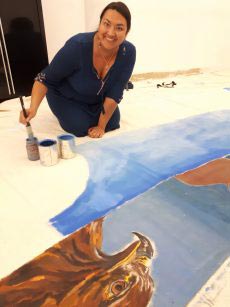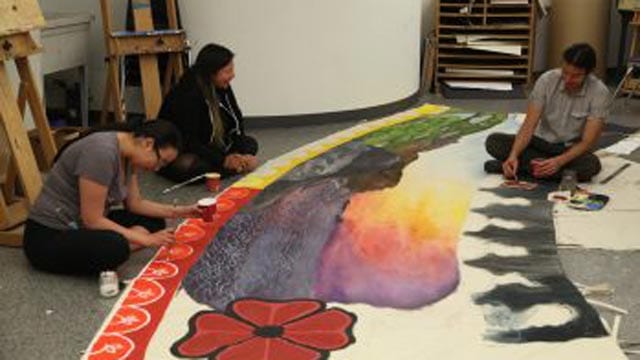Special to APTN News
Larissa Kitchemonia sits cross-legged on the floor chatting with other artists as they dip their brushes in Tim Horton’s cups filled with water, and paint on canvas tipi liners.
The artists are students and alumni of the First Nations University of Canada (FNUC).
“Collaborative painting comes with its challenges,” said Kitchemonia. “This project turned out to be a good mix of different areas of interest…there’s always things to learn from each other.”
While most of the artists are from Saskatchewan, Adam Martin is from Six Nations and Bruno Hernani is from Peru.
The students are painting a series of 50-foot wide canvas liners that will be installed in each tipi.
“They’re huge,” says artist Jori Cachene. “There’s three of those in the big tipi, so it’s a gigantic job.
“What we decided to do was amalgamate all seven artists (and) work on the largest tipi together. We came up with the themes together and… incorporated everybody’s ideas into one design.”

The theme of the main tipi is “those who have gone before,” said Peter Brass, Art Collection Manager at FNUC.
“It could be veterans, it could be missing and murdered Indigenous women and girls, it could be residential schools and children that passed away there, it could be Sixties Scoop.”
The liners will be installed inside 14 tipis on the lawn of the First Nations University campus in Regina.
Finding 14 tipis wasn’t easy, according to Brass.
“Tipi-makers are in high demand,” he says. “The people that could provide Cree tipis could only commit to making three. The other ones we ordered from the States, and they exclusively make Sioux (tipis).”
Roland Kaye, Elders’ helper at FNUC, was responsible for setting up the tipis of different sizes and styles – some had 13 poles, some had 15.
In the 1980s, a group of Saskatchewan Elders developed teachings to go with each pole, according to Kaye.
“Those values, I tell people, are instilled in each and every one of us,” he said. It’s not just a First Nations value or teaching–like love, or trust, or respect.
“Each and every one of us has that within us, to live like that. So, these teachings, to me, are a tool to live a better life.”
Using tipi poles as a way to teach values is a new development.
“I’m sure a hundred years ago, when they were putting up their tipi, they weren’t saying, ‘Here’s the love pole,’” said Kaye. “It was more or less survival–let’s get our camp together and survive.”
Still, says Kaye, “They’re good teachings. Everybody utilizes them at some point in their life. Schools use them, lots of institutions use them.
Cachene envisions the tipis being a gathering place over the summer months, a place for students and visitors to learn.
“We’ll be here all summer,” she said. “Come visit! Pull us out of our little paint world and come talk to us.”
Editor’s Note: APTN News is partnering with the First Nations University of Canada for the month of June to bring you stories from emerging Indigenous journalists throughout Indigenous History Month











Very interesting, Sheila. I learned new information that I had not known before reading your article. Thank you for writing this informative item. Lois Avison
Very interesting, Sheila. I learned new information that I had not known before reading your article. Thank you for writing this informative item. Lois Avison